Having put Heroes of the Home Front and the first edition of the WECA Comic Book Price Guide to bed last summer and having the fall and winter to relax from the scramble of getting these two projects together and published, it’s just about time to start thinking about a new undertaking.
A project similar to Heroes, but about one of the other main Canadian WWII comics publishers, is a pretty big mountain to climb. Resource materials are just not there in the same way that they were for the Bell Features context of Heroes. There is no repository of comics and original artwork concerning Anglo-American, Educational Projects, and especially Maple Leaf Publications as there is in the holdings of the Library and Archives of Canada for Bell Features. Another four or five year slog through the minutae of the last century as they might relate to the production of comics in Montreal, Toronto, and Vancouver is not an investment I am drawn to make as I approach my seventh decade, especially if it seems that the rewards won’t be there in the same way that they were for the exploration of Bell Features.
Doing a collection of reprints of the run of a certain WECA character is interesting and I would consider this for such characters as Ed Furness’ Freelance, Ted Steele’s Speed Savage and especially Hall and Walker’s Lucky (which runs almost the whole of the WECA period as a continuous serialized graphic novel). However, these have been done a couple of times or so already and don’t, for me, have the appeal of something that might be a little more challenging and a little more data driven and therefore result in something more informative.
A checklist and possible price guide for the FECA comics that followed the WECA period from 1947 to 1956 fits the parameters I would want to have and is very appealing, but again, the challenge here is daunting since there are probably over 5,000 individual issues to be dug up and taxonomized. This is eventually doable and information is being gathered and sorted now, but it is still some way off in the distance.
What I am drawn to do, and I welcome your opinions, suggestions, and caveats on this subject, is to assemble a Gerber-type Photo-Journal for the 800 or so World War II comic book covers that were produced in Canada. This would be a book that creatively and expertly reproduces full-colour covers for each of the comics enumerated in the WECA Comic Book Price Guide. Underneath each cover reproduction would be a blurb offering some added details concerning that cover. Something like this could probably be accomplished in about a year with the stumbling block being locating the best reproducible covers for each book. There are three repositories of WECA comics here in Ontario with the Bell Features books at the Library and Archives of Canada in Ottawa and at the library archives of Ryerson University, while the archives of the D. B. Weldon Library of Western University in London hold Eddy Smet’s WECA comics collection.
In writing this column over the past half-dozen years, I have made friends with a network of major collectors of WECA comics that extends across the country. I’m sure that many, if not all, of these collectors would be willing and pleased to contribute scans of any needed scarce issues and they would, of course, receive credit for doing so in the volume.
I am confident that, with all these resources, we could easily get 99% of all the WECA comic covers produced, leaving maybe 8-10 covers (mostly Maple Leaf Publications issues) that would present a real struggle and might be unattainable, but that’s just informed speculation at this point. This project, therefore, has a tremendous amount of appeal for me.
Now, most of you older collectors will have copies of the original two-volume Gerber Photo-Journal Guide to Comic Books published in 1989 somewhere on your comics-related bookshelves—probably laying flat, because each volume measures 14.75” X 10.25”. I bought my copies at the Hamilton Silver Snail Comics store on King St. E. just across from Aram Alexanian’s flagship carpet and flooring store the same year they came out and they’re still sitting on my shelves in the very same store bags I to carry them out of the shop (there’s a collecting strain for you—old brick and mortar store bags—what memories they would bring back).

Here’s what the first volume looks like:

Each of the two volumes contained images of over 10,000 American golden age comic book covers. They were displayed across each page in a grid varying from 4 X 4 to 5 X 5 to 6 X 6. The 4 X 4 grid showing 16 comics on each page only occurs a few times with the 25 comics per page and 36 comics per page grids relied on far more often. For the 6 X 6 presentation, the covers look like large postage stamps. Here is the first listing page from Gerber’s book for A-1 Comics followed by a sample layout for some of the ‘Cap’ comics:


As the dust jacket flap explains, the book also attempts to provide a categorizing system, relative values, and a scarcity index for each comic shown.
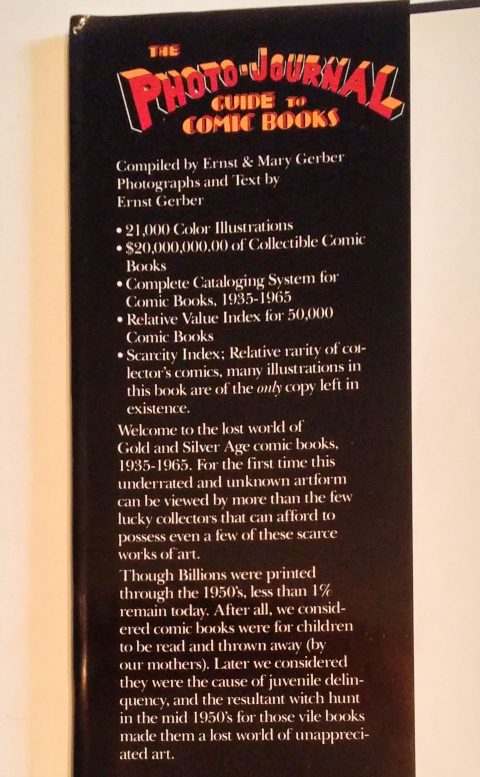
The categorizing system assigns a number to each title followed by a dash and a second number for each issue of the run. Gerber’s relative value index (RVI) attempted to develop a system in which comics weren’t assigned an actual dollar value but a value based on the relative values of one golden age comic to another. Action Comics #1, for example, was given an RVI of 34,500 and Boy Comics 61-80 were each give an RVI of 16, meaning that a copy of Action #1 in a given grade was roughly worth about 2,150 times what a comparable copy of an issue of Boy Comics from that 61-80 run was worth. Gerber’s scarcity index (SI) was based on Gerber’s informed understanding of how many copies of any issue were in existence. After three decades the only one of these three systems that seems to have stuck is the Gerber scarcity index and this is what one generally thinks of when the Gerber golden age photo-journals are mentioned.
Here is Gerber’s scheme for indexing the scarcity of a given comic:

This does seem like a reasonable index and a useful one that we could easily transfer over to a WECA Photo-Journal type of book.
Here is an example of Gerber’s listing of indices for some of the Captain America books:
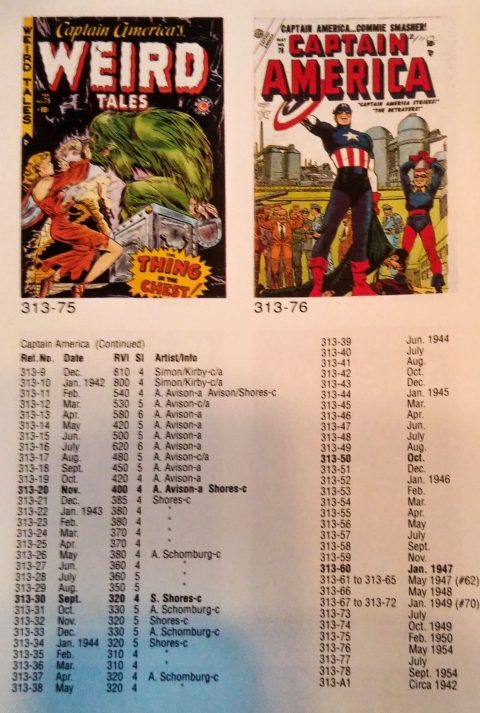
The “Ref. No.” means that this is the 313th title listed and the number after the hyphen is the issue. “RVI” is the relative value index to other comics in the volume and the “SI” is Gerbers ten-point scarcity index.
The size I’d propose for this photo-journal of Canadian war time comic would be the same as that for Heroes of the Home Front. That is 9” X 12” and I think that the optimal layout we could afford would be a simple 2 X 2 grid with four covers on each page. Each image itself would be about 2.5” X 4” or so in size and with 4 images per page, we’d need about 200 pages to display all the comic book covers and perhaps another 30 pages or so for additional text filler.
I used this 2 X 2 grid for the Gallery section of the WECA Comic Book Price Guide and it seemed fairly effective. Here is an example of a page from that Gallery:

There would just have to be a little more spacing provided at the bottom of each cover image to allow for an accompanying information blurb.
The information I’d propose to place under each cover image would include the following:
- Title and issue number
- Date or Date estimate
- Cover artist, if known
- Extra information such as first cover appearance, character featured, first cover by an artist, reproduction of an American cover, etc.
- Scarcity Index
The final item, the Scarcity Index, would probably have to be arrived at in consultation with leading collectors of these comics. Their consensus would be based on years of encountering these comics during their collecting experience.
The order of listing the covers would follow that of the WECA Comic book Price Guide and be alphabetical. Here is a mock up of a listing for the second issue of Better Comics with an initial attempt at a text box information layout for the book:
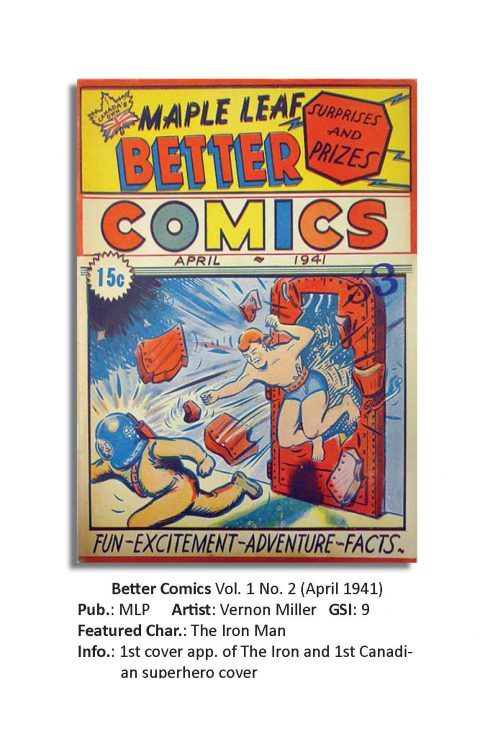
At this point, one question to consider would be whether or not to feature some select covers full-size or just to keep the 2 X 2 layout throughout the book. A couple of dozen select covers could be featured this way without adding too much to the overall size of the book and may add to the desirability of the collection.
Lastly, what would be the most effective background or field on which to present the 2 X 2 cover grid? My first thought is just a simple, blank, white background but, having a look at the impressive new L. B. Cole cover collection: Black Light: The World of L. B. Cole, solid black might be a consideration. Take a look at this Fantagraphics video. L. B. Cole’s primary colours really pop on this black background. I’m not sure that the Canadian covers would, but it’s a consideration. The other option here might be a background field of faded black-and-white or sepia-toned panels from the inside of the books being featured.
With this structure and layout in mind, the task would be to scan or photograph as many WECA covers as possible and select the best results for listing in the WECA Photo Journal. The reality facing us is that, for many issues, the best available cover may not be a high grade (remember that, for these first Canadian books, CGC 6-8 is a high grade with CGC 9 and up very difficult to find) so that even if the best cover we can find for a given book is a 2.0 or less, it should still be featured.
Obviously, we also mustn’t forget those few dozen remaindered coverless issues put out by Century Publications in 1946 which were intended for UK distribution. Even though they don’t have covers, they should be recorded as they were offered on the newsstands. Here is a sampling:

These are a hodge-podge of remaindered American reprints imprinted with a Century logo stamp and vague (no title, no date) indicia. It looks like Century/Superior was trying to squeeze the last drop of value out of these non-sellers overseas.
Another thing of interest that it might be worth considering would be a small appendix of stand-out back covers from the WECA period. These are sometimes quite interesting and striking and you never see them on the Grand Comics Database. Here is a gallery sampling of some:
There you have my ideas for a follow-up project to Heroes and it’s one that I’d hope would have more appeal to one of the established publishers so that maybe we wouldn’t have to rely on a Kickstarter though that would always be there as an option.
Again, I encourage and welcome your thoughts and suggestions on a Gerber-style photo journal presentation of all the WECA covers with the bottom line being: “Would you pick one up?”



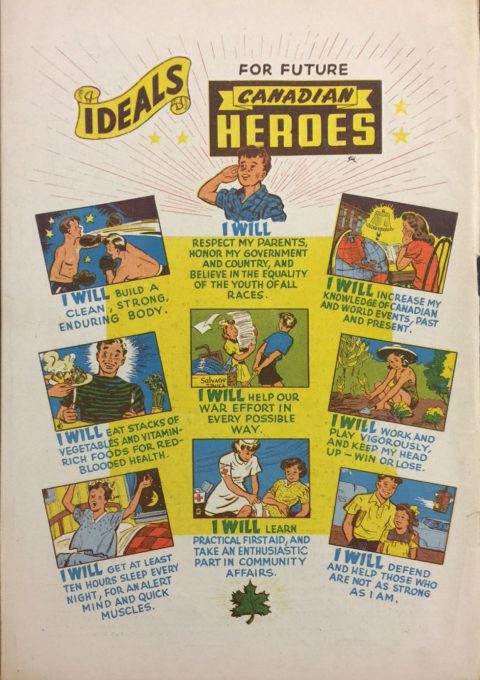






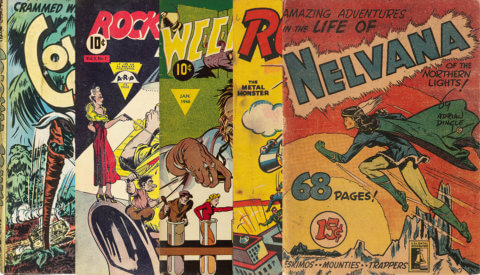


Ivan !
I’d buy a book like this in a heartbeat . I missed your original kickstarter but bought the price guide from you { 2 copies } and the signed one from Bud Plant recently . I like the idea of 2 covers on each page , esp. since I too am getting older and would need a magnifying glass to look at the covers like I do with the Gerbers ! I’m sure the S.I. would be quite high on these books , since there are probably less than 25 copies of each book floating around out there . once again , i’ll ask my friend if he would be open to letting his collection be photographed for this book . I believe he has between 350 and 375 weca books . if he agrees , i’ll send you his info !
info on all books is a great idea , imo ! if a back cover has some nifty art , I’d be down with seeing that , too !
all of this work you’re doing is absolutely superb in preserving our Canadian Heritage , hurrah to you , Sir !
that’s all from the west coast !
4.5
Thanks Chris, I may need to rely on the whole network of WECA collectors to help by scanning some of these rare comics in hi-res. All contacts and connections will help out. It would also help if we could get a publisher/distributer to pick this up without having to go through a Kickstarter, but Kickstarters can get things done, and done properly as well.
Hi there Ivan!
This would be a fantastic tome to say the least.
I imagine you would be able to cull images of most, if not all, of the Bell Features Publishing covers for LAC.
However, as you suggested, there are the other publishers from the WECA era to be considered:
F.E. Howard
Rucker Publications
Anglo-American Publishing
Maple Leaf Publishing
Educational Projects.
That said, I possess well in excess of 500 WECA books and I would certainly be willing to scan some of the rarer ones that you may not have access to, if the need arises.
Cheers,
Stephen
Thank you Stephen. This is the kind of networking that would need to be done to allow this project to succeed and all the contributors would, of course, be credited. The trouble is that scanning properly works only for raw copies while slabbed books need to be carefully photographed to avoid glare from the cases, but this can be done.
This is the logical next step, Ivan. Leave the FECA stuff for later. A Gerber-style guide is really the final step to bookend your ongoing project. I like your layout concept and the idea of keeping the scarcity index, though the small number of extant copies of each book may require tweaking the scarcity index in some way. One of the things that I love about the Gerber books is that you can lose yourself in them and find something new on every viewing. If you can capture the essence of the original books (and I think you can and will) then this will be a very successful project. If this comes to fruition, there will be a place on my bookshelf for one! Of course, any assistance that I can offer will be made available.
The majority of my collection of WECA books are raw and not slabbed, so no worries there!
Without any doubt or question, I would buy this. I’d urge you to keep the format as close as possible to the Gerber books though. I’m sure it’d be a worthy companion volume.
That is an awesome and great idea. Maybe an occasional full page cover for the more important books. Nelvana red cover for example.
Steve and Peter, thanks for your encouragement and statements of worth for this proposed project. I think it’s eminently doable and doable with the quality necessary and the quality that it demands.
The only problem that I can foresee is if someone has a number of comics that they would like to photograph and submit but is rejected due to the fact that you already have better versions. To save on duplication of effort, if there was some way to check out what has already been submitted, then contributors with lesser condition material would not have to waste their time.
If there was a special website that only submitters could access, then they can check out what has already been submitted and judge whether their stuff is better. If not, their efforts may be rejected and inadvertantly cause hard feelings. Just my opinion.
If you want a book publisher Ivan, may I suggest that you look into Abrams distributed through Canadian Manda Group. Nice related products (art, comics) at good price, however I don’t know what their minimums would be for a print run.
Klaus, thanks for your helpful suggestion. I hope to minimize this possibility by establishing a broad base of scans with materials available at the three Ontario archives which have collections of these comics and by visiting collectors in the local Southern Ontario region (where the greatest concentration of solid collections of these books seem to be). Once I can see the scope of this foundation of scans for the project, I can figure out the best way to move on to get the best scans of the remaining books and your suggestion may be the way to move forward at that point.
I haven’t heard of Abrams, Jim, but I’ll certainly take a good look at them. Thanks.
Ivan
I am so happy to hear you are considering taking this on as, I’m sure, if anybody could get it done, you could. Of course you know I am on board for any scanning of my books you may need. I was more than happy to see my copy of Nelvana featured in your price guide instead of the store-stamped, fingerprinted Bell copy that is featured in most books on the subject. The Gerber books have always been one of my go-to resources for info on Golden Age comics (The two Marvel volumes are invaluable as well. It’s a shame Ernie died before he saw his dream of an additional DC Gerber guide fulfilled.) and a similar guide to the WECA books would, I’m sure, go far in raising awareness of these great examples of Canadiana. You are lucky enough, too, to have a huge network of fans and collectors that could help you amass a large selection of these covers for such a book. If there is anything I can do to help please feel free to get in touch. We’re almost due for another breakfast soon anyway!
cheers, mel
Ivan, Abrams is one of, if not the largest Art Book publisher in the U.S. They also have a comics division, or at least did at one time, and have done collections put together by Craig Yoe, Art Spiegleman, Mike Barrier, I believe, and others. They are the top of the heap in the world of art, if you can interest them. Personally I think its a bit to specialized for them. Google “comic books + Abrams” then images, to see some of their titles.
Twomorrows could be a candidate again, because I think this would be more popular than probably either of your other books. It’s more universal in appeal. IDW should also be approached, and Dark Horse, both might think it a worthy project. Get to Mike Richardson at DHC, if he likes it, he’ll do it regardless of commercial evaluations. IDW would be Scott Dunbier, he’s in charge of projects. [email protected]
Brian Campbell put it all very well. I agree that post-WECA (FECA sounds like a dirty word) material is really not going to be very commercial–quite the opposite of this.
Mention of a format above makes me suddenly wonder if you might consider doing it in the same oversize format as Gerber, and with black covers, dust jacket and design, tie it in to the series. That could make it “fit” for collectors to add to their Gerber volumes. It’s a slightly awkward size, since you are running far less books, so it could be a bit thin. But you might just think about it. That said, doing it the same size as Homefront Heroes also offers consistency with your own book, and is a handsome size to work with.
Want to also vote for occasional full page reproduction, if you choose the smaller format you suggest, with the 4x on others. Certainly all the backcovers and ad pages you can fit. I love these things, I find it endlessly fascinating to see what publishers chose to endorse about their own books, and how they did it. The house ads from Timely, Novelty, Standard/Nedor and other Golden Age publishers are a lot of run, and rarely seen. This would further expose interior art for WECA books, too.
Scarcity Index is a must; counting on slabbed copies like many do this days is plain silly, since there are so many more unslabbed books. Gerber, while some of his data should be updated, is a good general guide all these years later. I would also suggest you add at least some of the best-known (and most skilled) artists in individual book credits for their interior work, again like Gerber.
In fact, the more you can match what Gerber did, the more you can sell this as a supplement for all the folks who have and use Gerber. I know you addressed credits in the WECA Price Guide, but for one, that’s out of print now and very limited, and secondly, many people interested in history (i.e. libraries) don’t necessarily want or need a priceguide. So the credits bear repeating in this instance.
Very happy to know this is your next project. It will finally put a real face on the entire WECA output.
Bud, thanks for taking the time to make those valuable suggestions. Your experience and advice is something of heavy worth in this hobby/industry. I’ll contact all those publishers when the time comes and we always have a Kickstarter to fall back on if we have to. First, I’ve got to see what we have and how many good cover images we can assemble together over the coming year.
Along with you, a couple of people have commented on the ‘ugliness’ of the FECA acronym and perhaps this terminology needs to be reconsidered. One quick alternative might be the clumsy EECA since the act that brought these reprint comics about was best known as the “Emergency Exchange Conservation Act.”
I think that the best fit of book size for this new project is that 9″ X 12″ size that I used for Heroes and, with a 2 X 2 cover grid, it should give us plenty of space to add extra info about each book. I’d like to translate the art quality and information quality of Gerber into this size. I’ll post things/samples of page layouts in this column as things develop and, if I’ve got the honest advice of individuals like you, Bud, and many of my other friends in this hobby, I feel confident that I can put out a quality product that will add to the knowledge of this period in Canadian comics.
Mel, thanks for your encouragement and friendship. Your honest opinion about and eager help with my projects are two things I know I can always rely on. Now that the snow and ice has receded (I hope!), it should be time for a welcome chew and chat breakfast at Symposium again.
EEEEECA brings up the image of someone who just bought a big stack of American comics for insane money and then realizing that thdy’re Canadian reprints. I picture their hair standing straight up. I don’t mind FECA.
Thanks for your 2 cents, Klaus. The other name we might consider would be the simple “Canadian Reprint Period (CRP)” but even when the reprints stopped before the Comics Code the period continued through the existence of Superior Comics with original material coming out well into 1956. I guess we need a name that covers the whole period 1947-56.
How about CORE? Canadian Original and Reprint Era.
Well, I’d like to read ALL of the Canadian Whites complete, but until a super wealthy publisher shows up this type of book would be a fabulous and worthy project. You can do it! I just opened your Heroes package today so I know you can. I wouldn’t be able to kickstarter (no cc) but I’ll support this somehow, someway.
Lots of work and process for you but you seem to have the connections. Hopefully the collectors of the treasures will want to share. I’ve not previously looked at the Gerbers (now, I do. One thing always leads to another… I just linked to the Digital Comics Museum too…) but I’d vote to match your Heroes book because it’s your book.
Awaiting further news!
hey Ivan, I’ve been backtracking through your posts (on page 8 now) and these fabulous, intriguing and just so interesting covers, pages and house ads keep popping up. So, yeah, I’m more and more interested in this book too. Take! My! Money!
a) Would it help to have a pre-book fund in aid of getting the photography rolling? – I got some cash.
b) Will this website be up forever, is it EMP proof, does it need funding? – I can see me viewing this place a lot.
c) Most of your posts seem to be a possible basis for yet another book on the history of WECA as an overview even if you can’t flush out all the details (sort of like you first thought of doing before focusing in on the Bell Features). It’d be a worthy book, I’m finding out so much I never knew.
d) Would this kind of project qualify for a Canada Council grant for historic/artistic preservation reasons?